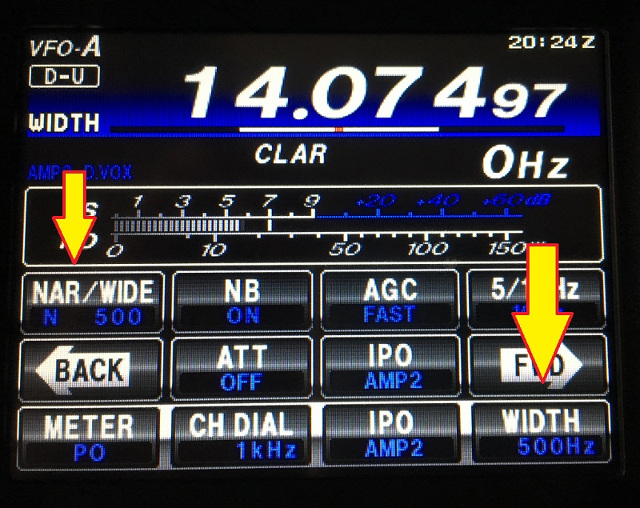-
Notifications
You must be signed in to change notification settings - Fork 16
Using FT 991A Filters to Improve your FT 8 Reception
So you are in the early morning, trying to take advantage of greyline propagation, you are almost working that China or Korean station when then suddenly... Well, that good nearby fellow ham radio operator starts operating at the same FT8 time slot of yours. What to do? Go to a quiet room and weep a bit? Cuss or curse the fellow operator?
Nah. Work it out.
I found two very useful tools in FT-991A, which surely can be used by any modern transceiver. Namely: Notch Filter and Bandwidth Filter. Let's examine each of them.
A picture is worth a thousand words.

On the above screenshot, I had CX4ACH and LW4EAZ (red arrows) pouring a very strong signal here. How to wipe them out?
At the frequency slider, I identified the center frequency that they were transmitting (around 970 Hz, Orange arrow) - and all I had to do was enable the 991's NOTCH Filter to 970 Hz:
The result?
CX4ACH and LW4EAZ were wiped out, UN7VZ raised from -22 to -17; DL3TW raised from -11 to -10 dB (green squares) - and the general reception also improved; the strong signals attacked my radio AGC - and since the notch wiped out these signals, you can see the background got noticeable lighter after I notched the signals.
This is a bit more laborious and requires a bit more of fiddling.
By default, we will want the radio's front-end as wide as possible right, so we can see as much signal of interest as possible, right? That translate to usual 2.4 kHz to 3 kHz of bandwidth that is captured by your radio and rendered by the FT8 software.
But - How do I manage to receive only that signal and getting rid of everything else?
The WIDTH filter might come to your rescue. First of all, you have to center your signal of interest to around 1 kHz. Of course the strong nearby signal will make your life harder so play with your estimates or you can also add or subtract to your VFO frequency. And finally, narrow down your bandwidth to get rid of the interfering signal! See the below picture:
So, I moved the signal of interest to around 1 kHz, selected the Narrow bandwidth filter (500 Hz) and finally the interfering signal is entirely off the scope - and even more signals popped up.
FT-991A settings:
-
AGC: Use
FAST. -
Noise Blanker:
ON. Turned out good results from me blanking out some interference - Amplifiers: Use minimal setting enough to have your S-meter swinging above S0.
- Bandwidth filter: Normally as wide as possible. Narrow it to dodge interfering signals.
-
NAR/WIDE: Generally,
WIDE. Use theNARROWmode when seizing some target signal. -
CONTOUR: Not of help in FT8, should be
OFF. -
DNR: Avoid as it might distort the signal of interest, should be
OFF. -
DNF (Autonotch): MUST be
OFF. The DNF is meant to silence off signals with a constant carrier, such those dear fellas that tunes over a frequency that is in use. FT8 tends to be perceived as a offending signal and might be notched out thus this should remain off -
SHIFT: Interesting to get rid of strong signals at the band edges. Should be at
zeroand used in a as-needed fashion.
Hope that helps!
Happy videobingoFT8ing,
- Rodrigo, PY2RAF.

